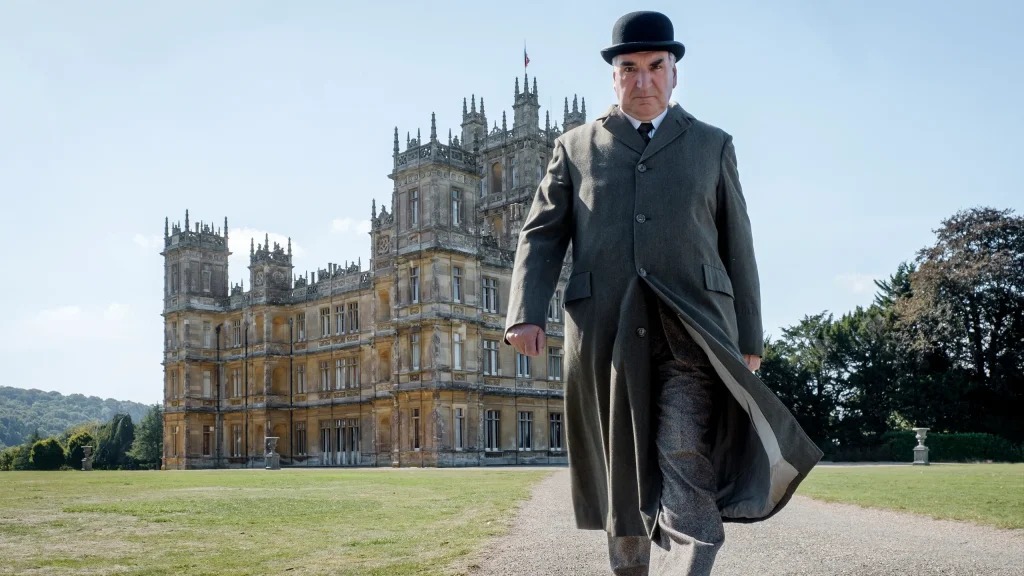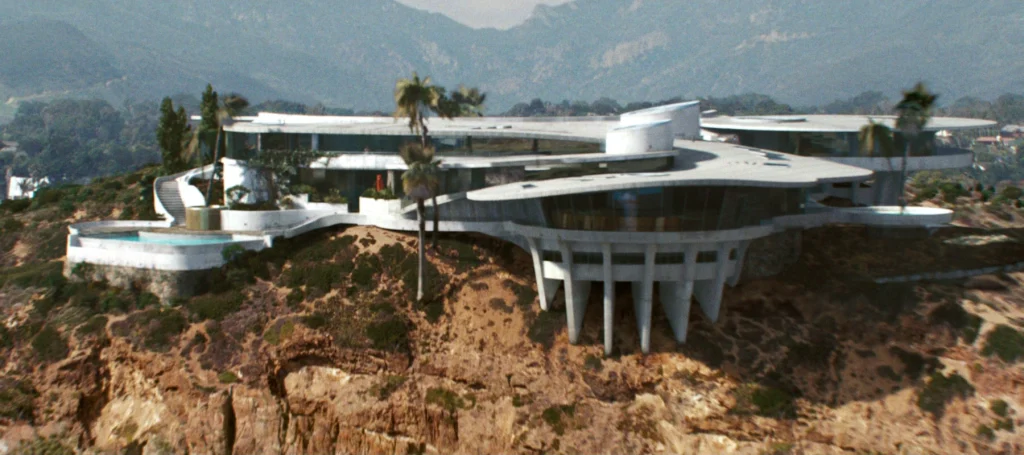There are many ways to make money out of property. Here we explore an alternative to the familiar buy-to-let or redevelopment strategies.
Does your property have what it takes to be used as a film location?
If so, it could he earning you anything from £1,000 to £125,000 a year. When Hugh Grant peeled off Renée Zellweger ’s huge knickers in the film Bridget Jones’s Diary , he did so in a loft apartment with the help of moody lighting and stunning views. Such gorgeous apartments are the movie stars of the location business and earn salaries to match (£50,000-£100,000 is not unusual), but there are thousands of more pedestrian homes used in photography shoots for magazines or commercials. Indeed, the ‘ordinary’ look is very much ‘in’ and renting out your house for such work can still bring in up to £25,000 a year.
The essential requirements are light, space, access and convenience. The privately owned house that was used in the filming of Great Expectations – a Georgian mansion set in 18 acres between Potters Bar and Barnet – is ideal. The rooms are big and airy with plenty of historical detail, the house is near the M25, reducing the crews’ traveling time and keeping production costs down, and the large, sweeping drive means parking for ten film trucks isn’t a problem. For convenience and cost- efficiency’s sake, 90% of film shoots take place close to London, which make suitable properties in the outer suburbs highly sought-after The best payers are reality TV shows. One house used in a recent programme in Highgate, north London, a 94-room Victorian monster, was rumoured to have earned its owners £125,000 because, unusually, the property was required for three months.
Other features sure to get location managers slavering are wooden floors, large windows or French doors, big fireplaces and chandeliers and claw-foot baths. Ideally, rooms should he painted in pale colours as they are easy to design the set around. The only drawback to all this is that it’s like six oil tankers turning up at your house for a party. That’s what you have to be prepared for. You must enjoy having people around, or be ready to leave for the term, but with thousands of pounds in your pocket in return for the slight inconvenience, it might well be worth your while.
What makes a property suitable for film locations?
When it comes to selecting a property for film locations, several factors contribute to its suitability. Here are some key aspects that make a property appealing to filmmakers:
- Unique and Versatile Features: Properties with distinct architectural styles, stunning interiors, or unique elements like grand staircases, vintage details, or modern design can add visual interest to film scenes. Versatility is also crucial, as spaces that can be easily transformed to suit different time periods, settings, or moods are highly desirable.
- Size and Layout: The size and layout of a property play a significant role. Spacious interiors, multiple rooms, and open floor plans provide flexibility for camera angles, lighting setups, and accommodating crew members and equipment. Properties with diverse areas like living rooms, kitchens, bedrooms, and outdoor spaces offer filmmakers various options for storytelling.
- Accessible Location: Film productions prioritize properties located in areas with easy access to transportation, amenities, and essential services. Properties close to major cities, airports, or natural landscapes that provide picturesque backdrops are particularly sought after.
- Ample Parking and Loading Facilities: Film productions require a significant amount of equipment and vehicles. Properties with ample parking spaces, both for crew vehicles and equipment trucks, as well as accessible loading areas, make logistics smoother for filmmakers.
- Noise and Privacy Considerations: Filming often involves a certain level of noise and activity. Properties located in areas with minimal external noise disturbances or those that offer sufficient privacy for the production team are highly valued. This ensures that filming can take place without disruptions and protects the confidentiality of the project.
- Infrastructure and Amenities: Properties equipped with necessary infrastructure, such as electrical capacity for lighting and equipment, reliable internet connectivity, and functional plumbing, enhance their appeal. Additional amenities like dressing rooms, green rooms, and production office space can also make a property more attractive to filmmakers.
- Historical or Iconic Significance: Properties with historical significance or iconic status hold particular appeal to filmmakers. Such locations can add authenticity and interest to period pieces, documentaries, or films that require a specific cultural or historical backdrop.
- Cooperative and Accommodating Owners: Finally, property owners who are willing to work with film productions, understand the unique requirements of filming, and are flexible with scheduling and access arrangements are more likely to attract filmmakers.
By considering these factors, property owners can determine if their property has the potential to be a suitable film location. Collaborating with location scouts or contacting local film commissions can provide valuable insights and guidance in assessing the suitability of a property for film shoots.

In-Demand Properties for Film Shoots: What Filmmakers Look For
When it comes to selecting properties for film shoots, certain types of properties are in high demand. Here are some property types that filmmakers often seek:
- Residential Homes: Residential properties, such as houses, apartments, or mansions, are frequently used for filming. These properties offer versatile settings for various film genres, including dramas, comedies, thrillers, or even horror films.
- Historical Buildings: Historical buildings, such as castles, stately homes, or heritage properties, are popular choices for period films, historical dramas, or projects that require an authentic vintage setting.
- Unique Architectural Structures: Properties with unique architectural designs, such as modern or futuristic buildings, iconic landmarks, or unconventional structures, catch the attention of filmmakers seeking distinct visual aesthetics.
- Commercial Spaces: Commercial properties like offices, restaurants, hotels, or shops are in demand for scenes set in business environments or specific settings, such as cafes, bars, or luxurious settings.
- Industrial Locations: Industrial properties, such as warehouses, factories, or manufacturing plants, offer gritty and raw backdrops for action films, thrillers, or projects with an urban or industrial theme.
- Natural and Outdoor Settings: Properties with scenic outdoor spaces like gardens, parks, forests, or waterfront locations are sought after for their picturesque backdrops. These settings are often used for romantic scenes, nature-based films, or projects that require a specific ambiance.
- Cultural and Landmark Sites: Landmark sites, cultural institutions, museums, or famous tourist destinations hold significant appeal for filmmakers. These locations add authenticity and interest to films set in specific cities or countries.
- Unique Interior Design: Properties with unique interior design elements, such as modernist or minimalist aesthetics, artistic decor, or thematic styling, are valued for their visual impact and ability to enhance the storytelling.
- Abandoned or Derelict Buildings: Abandoned or derelict buildings with a sense of decay or post-apocalyptic ambiance are sought after for projects that require a gritty, desolate, or dystopian setting.
- Versatile Spaces: Properties that offer versatile spaces, such as studios, soundstages, or empty warehouses, are in demand as they can be transformed to create custom-built sets tailored to the specific needs of a film production.
It’s important to note that the demand for properties can vary depending on the specific needs of each film project. Location scouts and film production companies often have specific requirements and preferences based on the script, genre, and creative vision of the film. Property owners interested in making their property available for film shoots can work with location agencies or reach out to local film commissions to showcase their properties and attract potential filmmakers.

How can I determine if my property has the potential for film location rentals?
When considering if your property has the potential to be rented as a film location, there are several factors to assess. Here are some steps to help you determine if your property could be a viable option for film shoots:
- Research Film Locations: Familiarize yourself with films or TV shows that have been shot in your area or properties similar to yours. Look for similarities between your property and those used in productions to get an idea of the demand for certain types of locations.
- Assess Property Features: Take a critical look at your property’s unique features, architectural style, interior design, and surroundings. Consider any standout elements that could make it appealing to filmmakers, such as historical charm, modern aesthetics, distinctive rooms, or expansive outdoor spaces.
- Location Accessibility: Assess the accessibility of your property for film crews and equipment. Consider factors like proximity to major roads, parking availability, and the ability to accommodate production vehicles and equipment without causing disruption to the neighborhood.
- Space and Versatility: Evaluate the space and layout of your property. Determine if it offers versatile areas that could be transformed to suit various filming requirements, such as open-plan interiors, large rooms, or flexible outdoor spaces.
- Lighting and Sound Considerations: Consider the natural lighting conditions and acoustics of your property. Properties with ample natural light and good sound insulation are often preferred by filmmakers as they reduce the need for extensive lighting setups and soundproofing during filming.
- Permits and Regulations: Research the local regulations and permit requirements for filming in your area. Familiarize yourself with any necessary permits, restrictions, or homeowner association rules that may apply. Ensure you are willing to comply with the necessary paperwork and guidelines.
- Property Condition and Maintenance: Assess the overall condition of your property. Make any necessary repairs or improvements to ensure it is in a suitable state for filming. Keep in mind that properties in well-maintained and aesthetically appealing condition are more likely to attract filmmakers.
- Promotion and Networking: Explore ways to promote your property as a potential film location. Connect with local film commissions, location scouts, and production companies to showcase your property and make them aware of its availability. Consider creating a portfolio of professional photographs highlighting the unique features of your property.
- Collaborate with Location Agencies: Consider working with location agencies or property management companies that specialize in connecting property owners with filmmakers. These agencies can assist in marketing your property, negotiating rental agreements, and handling the logistics of film shoots.
- Flexibility and Collaboration: Understand that renting your property as a film location requires flexibility and collaboration. Filming schedules can be demanding, and your property may undergo temporary modifications to suit the production’s needs. Ensure you are comfortable with these aspects before considering renting your property to film crews.
By evaluating these factors and understanding the unique qualities of your property, you can make an informed decision about its potential as a film location rental. Consulting with industry professionals or seeking guidance from location agencies can also provide valuable insights and increase your chances of attracting filmmakers to your property.
What are the benefits of renting out my property as a film location?
Renting out your property as a film location can offer several benefits:
- Rental Income: One of the primary advantages is the potential for substantial rental income. Film productions often pay competitive rates for the use of properties, providing an additional revenue stream.
- Exposure and Promotion: Having your property featured in films or TV shows can bring significant exposure and promotion. Your property may gain recognition and be showcased to a wide audience, which can be beneficial if you are looking to sell or attract future rental opportunities.
- Preservation and Restoration: Film productions may cover the costs of restoring or enhancing your property for the shoot. This can be advantageous if your property needs renovations or updates, as it allows you to improve its condition without bearing the expenses.
- Minimal Tenant Disruption: Unlike traditional long-term rentals, film shoots are usually short-term engagements. This means there is less impact on your property and less disruption to your daily life compared to having long-term tenants.
- Unique Experience: Renting your property as a film location can provide a unique and exciting experience. You may have the opportunity to interact with industry professionals, witness the behind-the-scenes filmmaking process, and be part of creating cinematic works.
Are there any drawbacks or challenges associated with using my property for filming?
While renting your property as a film location can have numerous benefits, there are also some drawbacks and challenges to consider:
- Disruption and Inconvenience: Film shoots can be disruptive and may require temporary modifications to your property. This can involve moving furniture, setting up equipment, and potential noise during filming. You need to be prepared for the inconvenience and potential disruption to your daily routine.
- Property Damage Risk: Film productions involve various equipment and activities that can pose a risk of accidental damage to your property. Although productions typically have insurance coverage, there is still a possibility of unforeseen damage. It’s important to discuss insurance coverage and safeguards with the production company before agreeing to the rental.
- Limited Availability: The demand for film locations can fluctuate, and there may be periods of time when your property is not in use for filming. It’s crucial to understand that renting your property as a film location may not guarantee a constant stream of bookings.
- Restrictions and Regulations: Local regulations and permit requirements for filming may vary in different areas. It’s essential to familiarize yourself with any legal obligations, permits, and restrictions associated with using your property for filming. Compliance with regulations and obtaining the necessary permits can be time-consuming and may involve additional costs.
- Privacy Concerns: Allowing a film crew into your property means giving up a certain level of privacy. Crew members and actors will have access to different areas of your home, and it’s important to be comfortable with this aspect before proceeding.
- Negotiation and Contracts: Renting your property as a film location involves negotiating rental terms and signing contracts. It’s crucial to review contracts thoroughly, understand the terms and conditions, and seek legal advice if needed to protect your interests.
By considering these potential drawbacks and challenges, you can make an informed decision about renting your property as a film location. It’s important to weigh the benefits against the challenges and ensure that you are comfortable with the potential impact on your property and lifestyle.
There are numerous examples of houses in the UK that have been used as filming locations. Here are a few notable examples:
- Highclere Castle (Hampshire): This historic estate serves as the iconic Downton Abbey in the popular TV series of the same name. Its grand architecture and stunning interiors have made it a sought-after location for period dramas.
- Hatfield House (Hertfordshire): Hatfield House has been featured in various films, including “Harry Potter and the Deathly Hallows,” where it stood as the grand exterior of Hogwarts School of Witchcraft and Wizardry.
- Alnwick Castle (Northumberland): Alnwick Castle is another famous filming location, most notably recognized as Hogwarts Castle in the early “Harry Potter” films.
- The Old Royal Naval College (London): This architectural marvel in Greenwich, London, has appeared in numerous films, including “Les Misérables,” “Pirates of the Caribbean: On Stranger Tides,” and “The King’s Speech.”
- Broughton Castle (Oxfordshire): Broughton Castle is a picturesque medieval manor that has been featured in films like “Shakespeare in Love” and “The Madness of King George.”
- Basildon Park (Berkshire): This stately home has been showcased in movies such as “Pride and Prejudice” and “Downton Abbey.”
These are just a few examples of the many houses and estates in the UK that have been used as filming locations. The country’s rich architectural heritage and diverse landscapes make it a popular choice for filmmakers seeking unique and captivating settings for their productions.
It costs nothing to register your property on the books of location agencies (Google them) – just supply drawings and photographs, inside and out; you may be surprise at what, or who, turns up. Further, a property that has featured in a quality film, commercial or magazine advert will command a premium price should one day you decide to sell. Make sure the register your rental properties as well as your own home. For a split of the money provided, tenants will happily decamp to other accommodation for a brief, yet lucrative, period.

